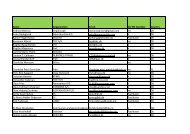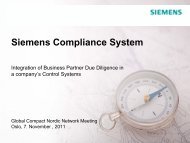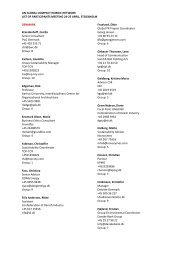Business Against Corruption - A Framework for Action - International ...
Business Against Corruption - A Framework for Action - International ...
Business Against Corruption - A Framework for Action - International ...
- No tags were found...
You also want an ePaper? Increase the reach of your titles
YUMPU automatically turns print PDFs into web optimized ePapers that Google loves.
10 <strong>Business</strong> <strong>Against</strong> <strong>Corruption</strong>CommitAs with most management challenges acompany faces, clear leadership is essential ifa company is to ensure that it and its agentsare not engaging in corrupt practices. It isimportant that the top management not sendmixed signals: on the one hand to urge companymanagers and representatives to applystringent codes and high standards, while onthe other to make it clear that these codes areopen <strong>for</strong> interpretation, often with referenceto the importance of adapting business practicesto the local environment.Thus, the first step any company shouldtake in fighting corruption is to have leadershipcommitments to zero tolerance ofbribery and to mainstream anti-corruptionpolicies into its everyday operations, doingso in a transparent way. Companies shouldensure that oversight of anti-corruption measuresis provided by transparent governancestructures within the company.AssessWith a firm commitment to fighting corruptionin hand, companies should assessthe risks and opportunities—in financialand extra-financial terms—found in en<strong>for</strong>cingstrict anti-corruption measures, as wellas the impact of their operations on thefight against corruption and vice versa. Byunderstanding the context and risks underwhich they operate, companies can gaina more comprehensive view of the scopeof the problem and the areas of greatestconcern and importance, and thus set highbut realistic goals achievable over a certaintime period. Companies should continuallyre-assess as circumstances change and aspolicies and procedures are shown to be successes(or failures).As a company identifies its risks, it mayfind areas of operation that, if improved, cancreate shareholder and stakeholder value.When dealing with corruption, this may bereadily apparent: Through its elimination notonly does a company avoid legal, reputationaland other risks, but the company also retainsmorale and capital, increasing the potential<strong>for</strong> efficient production.Finally, by assessing the impact of itsoperations and the impact of corruption onits operations, a company will be able to answerquestions posed by stakeholders and tocalculate the areas of high risk that should beaddressed first. Companies are encouraged tolook at the Communication on Progress andother sustainability reports of competitors tohelp determine the best ways to benchmarktheir own per<strong>for</strong>mance.DefineOnce a company has a comprehensiveunderstanding of its context, it should sethigh but realistic goals to adhere to the 10thPrinciple against <strong>Corruption</strong>, address its risksand pursue opportunities. As part of this step,companies should determine which indicatorsthey will use to measure their progressand to determine whether a particular policyor programme is successful.Once a company has defined its goals, itshould construct and adopt strategies andpolicies to achieve them. Such policies mayinclude an ethics code aimed at capturing thevalues that underpin an organization, andthey should be applied to all relevant businesspractices.Voluntary compliance with internal codesof business principles and ethics, and withexternal guidelines such as the <strong>Business</strong>Principles <strong>for</strong> Countering Bribery, which weredeveloped by a multi-stakeholder approachled by Transparency <strong>International</strong>, and the UNGlobal Compact’s 10th Principle, has the addedeffect of strengthening day-to-day compliancewith law and regulation. When companiesset and rein<strong>for</strong>ce high standards of behaviouras the norm, incidents of non-compliance arereduced and are easier to identify and correct.Codes and advice on ethics programmescan be obtained from organizations such asthe Ethics Resource Centre. Guidance on theintroduction of anti-bribery programmes isprovided by TI and the <strong>International</strong> Chamberof Commerce (ICC).In addition to such broad principles, thereare an increasing number of specific initiativesaimed at addressing some of the challengesthat may be encountered in particularsectors. The World Economic Forum—PACI,which began as a sector-specific project <strong>for</strong>the engineering and construction industry, isa pragmatic step toward broader implementationof anti-corruption measures.ImplementPrinciples and codes are rarely sufficient inthemselves; they have to be accompaniedby training and follow-up, ensuring that anethical culture is developed within a companythrough a consistent strategy. Continu-









